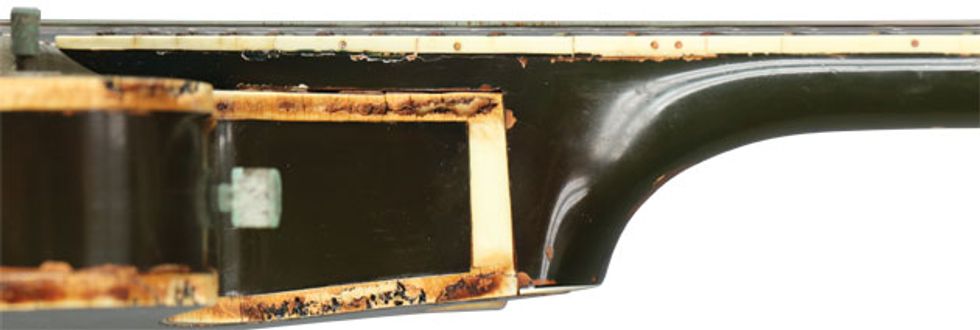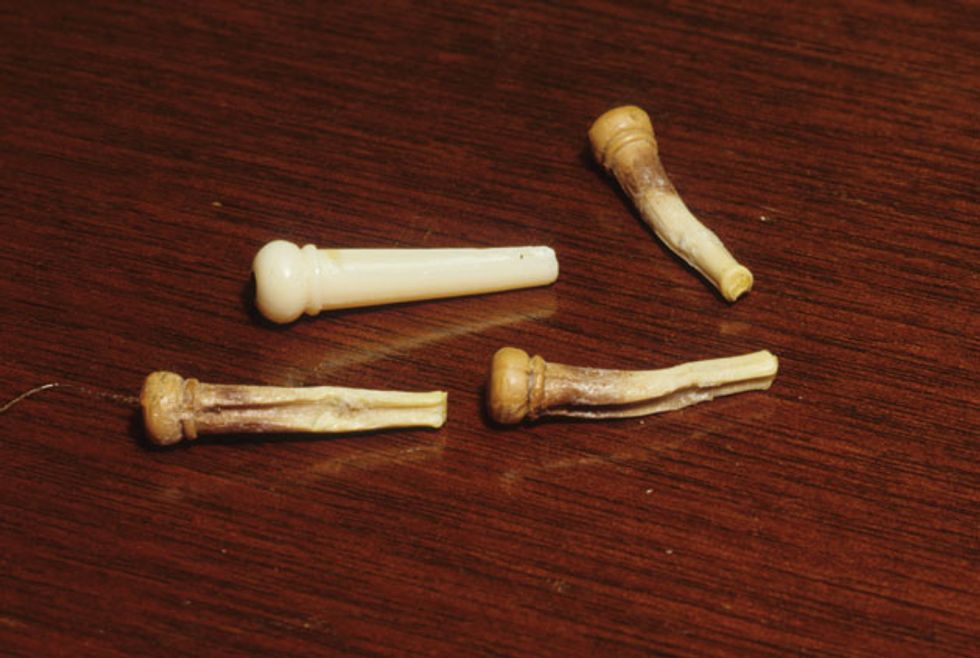Now that some vintage guitars from the mid-20th century are approaching the value of fine violins made 300 years ago, people tempted by the investment potential of old instruments often compare Stradivarius violins and high-ticket Gibsons or Martins. Just think of what that flame-top ’59 Les Paul Standard or a rare ’38 D-45 will be worth on its 300th birthday! There are, however, some critical construction differences that suggest guitar collectors have more to worry about than fires, floods, and flatpicks when it comes to protecting the originality (and value) of their most prized possessions.
The varnish and glue used by early violinmakers had already been in use for hundreds of years by the time little Tony Stradivarius started whittling with a violin knife. By the late 19th century, however, mass production of furniture and musical instruments brought more changes in just a few decades than instrument makers had seen in several previous generations.
The plant-based stains suspended in varnish that provided the subtle shading on violins and some early guitars were replaced by aniline dyes. Around the same time, the tortoiseshell and ivory that had been used to adorn the edges of high-grade instruments were replaced by a new and far more flexible material called celluloid—the first thermoplastic. This cellulose nitrate—made with nitrocellulose and camphor—was soon joined by a new type of finish we know as nitrocellulose lacquer.
Fretted-instrument manufacturers had no reason to doubt the longevity of celluloid, and the ease of making their wares more colorful and decorative soon led to a riot of contrasting lines of binding around richly colored bodies and necks, especially on the new jazz-age guitars and banjos of the 1930s. This new wonder material had a myriad of other uses. Thin and transparent rolls of it were used for movie film, while far-heavier stock was widely used for dice, combs, bracelets, and dresser sets. Most of what looks like ivory knobs on old guitar, banjo, mandolin, and ukulele tuners is actually ivory-grained celluloid.
Photo 2
We don’t know what makes celluloid decompose (aka “celluloid rot”), but we do know that when it fails, it often goes from looking great to looking awful very quickly. Some of the earliest instruments to display celluloid, such as those made by Washburn, Fairbanks, and Gibson, seem fine over a century after they were made, but a lot of guitars made in the 1930s and later are in serious trouble. The famed archtop builder John D’Angelico, who died in 1964, was rebinding some guitars he’d made less than 20 years earlier.
Is celluloid rot caused by the glue used to hold binding in place? Is it caused by the finish applied over it? Nobody seems to know for sure, but thick, suspended pickguards like those found on archtops seem most prone to early decomposition, even if they weren’t lacquered. The binding and pickguards on Martin flattops seem to rarely fall victim to celluloid rot unless the instrument is refinished with lacquer. If this sounds confusing, you’re not alone. Also baffling is the fact that not all the celluloid on the same instrument starts to decompose at the same time. Two or three bridge pins may shrink to less than half their original size while the rest of the set seems fine. And of the four pieces of binding on the body edges of a guitar, sometimes only one is affected, which suggests that differences in manufactured batches may have a role.
Musical instruments with celluloid pickguards, tuner knobs, and binding often reside in their cases for long periods, and when celluloid rot strikes in such a confined space, it isn’t just the celluloid itself that suffers. The outgassing of nitric acid often bleaches the case lining, tarnishes surrounding metal parts like frets or pickup covers, and discolors the lacquer as well. This collateral damage—especially to the gold plating on metal parts—is often far more costly to restore than the loss of the celluloid pickguard that caused the problems.
You’re more likely to run into celluloid rot in bridge pins and/or tuner buttons than anywhere else.
When celluloid rot is confined to small parts like tuner knobs, replacing them can be an easy fix. And because so many of the off-white celluloid knobs on tuners from the ’40s through the ’60s are shrinking and crumbling, the “gotta be original” mania surrounding vintage guitars seems to be showing a rare hint of reason. There’s not much point in paying a premium for a ’40s Martin or Gibson with its original tuner buttons when those originals could disintegrate in the next few years. There will be exceptions, but a general sense of inevitability has set in and a vintage Gibson J-45 with replaced celluloid buttons won’t necessarily sell for less than one with the original tuners intact.
The short lifespan of some celluloid has also wreaked havoc on newer guitars, including some from as recent as the 1990s. Elevated pickguards are easily replaced, and exact replicas are available for most models. Replacing disintegrating binding on a finished guitar, however, takes a lot more effort and skill. The 1969 Gretsch shown in Photo 1 needs all of the multiple layers of body binding replaced, and ideally, the green finish should be disturbed as little as possible—not an easy task.
Dice and movie film are no longer made of cellulose nitrate, but American guitar manufacturers and individual luthiers alike are still using lots of celluloid on high-end instruments, especially for vintage-reissue models. There’s a good chance that the new UV-cure finishes and modern adhesives will prevent celluloid binding from crumbling into dusty chunks, but only time will tell. The long-term result of demand for new guitars made “just like in the good ol’ days,” however, may make us wish we were more careful about what we wished for.




















